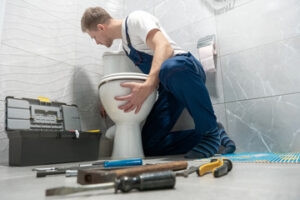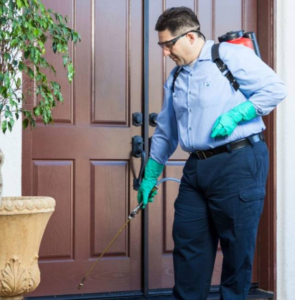Every house and business requires plumbing services. Plumber repairs leaky faucets, clogged toilets and drains, and installs new pipes and fixtures. Their work is important, and they need to be knowledgeable about safety rules and regulations.

Become a plumber by earning a high school diploma or GED certificate and completing an apprenticeship program. Many apprentices join unions, which provide additional training and support.
The job duties of a plumber include assembling, installing, and repairing pipes and fixtures. They also inspect plumbing systems to ensure compliance with local and state regulations. Plumbers must be familiar with a wide range of tools and techniques in order to complete their tasks. In addition, they may need to be able to read and interpret blueprints.
Depending on the industry, some plumbers work in residential settings while others work in commercial or industrial environments. The type of work performed in each setting varies, but all plumbers must be able to perform basic repair tasks and troubleshoot problems. Some common jobs include repairing leaks, replacing faucets and toilets, and unclogging drains.
Some plumbers may also be responsible for installing new plumbing in construction or remodeling existing structures. This involves laying out pipework and connecting appliances like sinks, dishwashers, and washing machines. Plumbers should be able to read and follow blueprints in order to properly install these systems. They must be able to work with contractors and other construction professionals in order to ensure that all necessary requirements are met.
In some cases, a plumber will be called upon to work on emergency repairs or situations that are outside of normal business hours. This can be a challenging part of the job, but it also provides a sense of fulfillment knowing that they are helping people in times of need. Plumbers must be able to work quickly and efficiently in these situations, and they should be able to work well under pressure.
Many plumbers also serve as mentors for apprentices and help them develop their skills and knowledge of the trade. This can be a great way to increase productivity and improve overall job performance. In addition, plumbers must be able to effectively communicate with customers and other team members. This is especially important when discussing complicated or expensive repairs. To ensure that all plumbing repairs are completed accurately and on time, plumbers must also be able to schedule their work correctly.
Education and Training Requirements
There are several qualifications you need to meet in order to become a plumber. First and foremost, you need to have a high school diploma or equivalent GED. You can then either enroll in a vocational training program or an apprenticeship program to learn plumbing skills. These programs typically last four to five years and combine on-the-job experience with classroom instruction. After completing your apprenticeship, you can then apply for a license to practice in your state.
During your education and training, it is helpful to have a mentor who can guide you through the process. You can find a mentor by reaching out to experienced plumbers in your community or through professional networking platforms. Mentorship can help you learn quickly, and it can also give you a leg up when it comes time to take certification exams.
Once you have a mentor, you should take the time to practice your new plumbing skills outside of class hours. You can do this by shadowing experienced plumbers at work or volunteering for a local organization that performs plumbing repairs. By gaining hands-on experience, you can develop the necessary skills and confidence to be successful as a plumber.
You should also make sure that you have the proper tools for the job. You can obtain these tools from your employer or from a plumbing supply company. It is important to invest in good quality tools as they will last longer and help you do your job better. You may also want to consider joining a professional organization. This can provide you with networking opportunities and additional resources for your career.
Once you have completed your training, you can begin working as a licensed plumber. You should check with your state’s licensing board to learn about the exact requirements. Most states require that you have a certain number of classroom hours and on-the-job experience before you can take the exam and receive your license. In addition, many plumbers are required to complete continuing education classes in order to maintain their licenses.
Work Environment
Plumbing is a trade that requires hands-on work and problem-solving prowess, and it also offers a sense of purpose. Whether they are installing an efficient water-saving system in a home or ensuring that industrial facilities are well-equipped to handle their piping needs, plumbers play a crucial role in the health and functionality of our societies and economies. As such, this profession is highly fulfilling and offers a variety of challenges that make it exciting and engaging.
For plumbers, the workplace environment varies depending on the type of projects they are engaged in. In residential settings, they work directly in people’s homes and apartments. This requires them to navigate tight spaces and work around furniture and other fixtures in order to carry out their duties. In addition to plumbing maintenance, they may be required to install new piping in renovation or construction projects. Plumbers also interact with homeowners or tenants to discuss their plumbing issues and provide estimates for repairs and installations.
Commercial and industrial settings are also common workplace environments for plumbers. These projects require them to install, maintain, and repair large-scale plumbing systems that serve multiple occupants. They may also collaborate with other professionals, such as architects or construction teams, to ensure that piping is properly integrated into the overall infrastructure. In addition to working on plumbing systems, they may be responsible for testing and repairing fire sprinklers and other complex equipment.
As a trade, plumbers value lifelong learning. This includes mastering new techniques and technology, as well as keeping up with building codes and regulations. In this way, they continue to grow in their career and stay at the forefront of their field.
Because of this, they are always on the lookout for training opportunities to expand their knowledge and skillsets. In addition, they also keep up with industry trends and best practices through self-directed professional reading and attending professional development courses. This continued learning helps them remain competitive in the marketplace and offer their clients the latest in innovative solutions. In addition, they must be on-call for emergencies and often work evenings and weekends.
Salary
A plumber’s salary can vary depending on their specialization, level of experience, and certifications. However, in general, plumbers earn a decent wage for their services.
For example, an entry-level plumber makes around $36,700 per year. A plumber with 2-4 years of experience can expect to make around $63,579.
Additionally, plumbers who specialize in certain areas can expect higher wages. For instance, a plumber who is a master plumber can earn up to $99,920 per year.
Plumbers typically work full time, although some also choose to freelance or run their own plumbing business. In addition to working normal business hours, many plumbers often work evenings and weekends to respond to emergencies. This is especially true for plumbers who work on large construction projects or for municipalities that are responsible for maintaining aging pipes and water systems.
The job of a plumber can be quite challenging, and it requires a high level of technical expertise. Additionally, plumbers must be able to effectively communicate with clients in order to understand their needs and provide accurate estimates. Finally, plumbers must be able to follow all applicable building codes and safety protocols when performing their duties.
Many plumbers work on construction sites, where they install new piping and fixtures. This type of work can be demanding, but it’s also rewarding because it allows plumbers to work with other tradespeople and see the results of their labor. Plumbers who work on construction sites also have the opportunity to learn more about different types of plumbing, including gas lines and sewer systems.
Whether you’re interested in becoming a plumber or are already in the industry, there are plenty of opportunities to advance your career. For example, many plumbers choose to specialize in green plumbing technologies that focus on water conservation. With time and experience, plumbers can even move up to supervisory roles or open their own plumbing businesses.
The demand for plumbers is expected to grow steadily over the next few years, making it a great choice for those who want to enter the skilled trades. In addition to offering competitive pay, a career as a plumber offers excellent job security and a chance to work with your hands.








